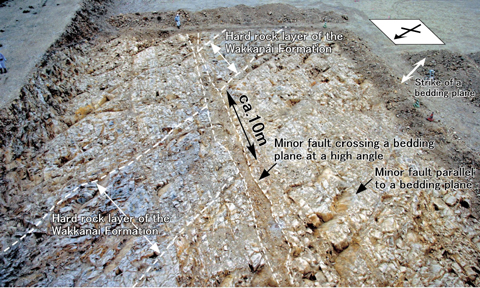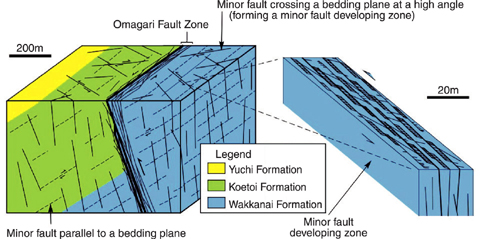
Fig.2-23 The observed outcrop

Fig.2-24 A conceptual model for WCFs
In order to evaluate migrations of radionuclides in rock masses around a geological repository for high-level radioactive wastes, ground water flow must be analyzed. For the ground water flow's analysis, the hydrogeological structure, i.e. distributions of hydraulic conductivities in rock mass, must be understood, in particular the water-conducting features (WCFs) which have high hydraulic conductivities.
The hydrogeological structure is inferred by an analysis integrating geological observations and in-situ permeability test data. If water-conducting features can be characterized to some degree only from geological observations, we can perform in-situ permeability tests selectively and infer the hydrogeological structure efficiently.
In this study, we performed geological observations for fractured sedimentary rocks in the Horonobe area, northern Hokkaido, Japan, and researched characteristics and distributions of WCFs in the rock mass (Fig.2-23).
Most of fractures in the rock mass were divided by their orientations and surface's occurrence into two types of faults; a minor fault crossing a bedding plane at a high angle (MFC) and a minor fault parallel to a bedding plane (MFP). In addition, MFCs, particularly collected in a high density zone called a minor fault developing zone (MFD), were inferred to be high potential WCFs, based on the nature of their alterations, orientations, densities and crosscutting relations. This inference agrees with the results of in-situ permeability tests and the spots where there is water loss during drilling.
Based on the orientations, direction of displacements, and crosscutting relations of MFCs, it is inferred that they were formed after uplifting, by residual stress which accumulated during folding. Based on this origin, it is inferred that MFCs are to be found in and around folds, which is actually confirmed at outcrops and boreholes.
In this way, hydrogeological structure was feasibly inferred to some degree from geological observations (Fig.2-24). We will be studying the relationships between the uncertainty of inferred results and a quantity/quality of investigations.
<Previous: 2-9 | Next: 3 Nuclear Fusion Research and Development >